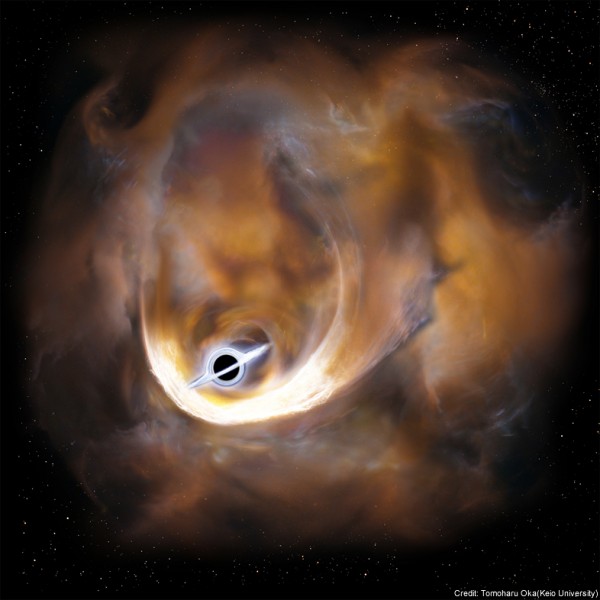By Ana Verayo, | January 17, 2016

Artist’s impression of the clouds scattered by an intermediate mass black hole.
A massive black hole is apparently hiding in the Milky Way galaxy disguising itself as a gas cloud.
Astronomers from the Keio University in Japan led by Tomoharu Oka detected this seemingly hiding black hole using the Nobeyama 45-meter radio telescope. They first saw an enigmatic gas cloud known as CO-0.40-0.22 some 200 light years away, from the Milky Way's core.
Like Us on Facebook
However, scientists later found out that this is not a regular gas cloud as the gas contained inside possesses varying range of speeds. The team also discovered that this gas cloud is shaped in an elliptical form, and possesses two crucial components. One low density containing a wide velocity dispersion of 100 kilometers per second and a denser component extending 10 light years, containing a narrow velocity dispersion.
After ruling out a supernova explosion, X-ray and infrared observations did not reveal any compact objects inside the mysterious cloud.
Using a simulation of the gas clouds, the team also incorporated a strong gravitational force factor where this revealed how the gas clouds were attracted to the source, increasing their speeds as they approach it. According to Oka, this black hole is the best candidate for a compact massive object, which will be the first time this type of cosmic object has ever been detected.
This new study can also provide a better understanding of the Milky Way galaxy and other galaxies as well, including the development of black holes. This can also pave way for new methods in searching for millions of black holes in our galaxy, and why supermassive black holes are more often than not found in the centers of galaxies.
To date, astronomers already know about two sizes of black holes, which are stellar mass black holes, forming after massive explosions of gigantic stars and supermassive black holes that are often detected in the cores of galaxies.
There are numerous supermassive black holes already found however, the mechanism behind it and how it is formed is still an enigma to scientists. One theory suggests that they are triggered by mergers from a number of intermediate mass black holes, however, there is still no direct, observational evidence proving that intermediate mass black holes exist.
Oka adds that the gas motion detected by radio telescopes can complement current techniques how to search for black holes. The Milky Way wide area survey observations conducted by the Nobeyama 45-m telescope along with high resolution imagery of neighboring galaxies by the ALMA (Atacama Large Millimeter/submillimeter Array) telescope, are also crucial in increasing the potential to detect more black hole candidates.
-
Use of Coronavirus Pandemic Drones Raises Privacy Concerns: Drones Spread Fear, Local Officials Say

-
Coronavirus Hampers The Delivery Of Lockheed Martin F-35 Stealth Fighters For 2020

-
Instagram Speeds Up Plans to Add Account Memorialization Feature Due to COVID-19 Deaths

-
NASA: Perseverance Plans to Bring 'Mars Rock' to Earth in 2031

-
600 Dead And 3,000 In The Hospital as Iranians Believed Drinking High-Concentrations of Alcohol Can Cure The Coronavirus

-
600 Dead And 3,000 In The Hospital as Iranians Believed Drinking High-Concentrations of Alcohol Can Cure The Coronavirus

-
COVID-19: Doctors, Nurses Use Virtual Reality to Learn New Skills in Treating Coronavirus Patients







